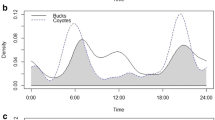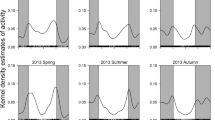Abstract
Competition has long been considered as a confounding factor of group size effect but the understanding of interference competition is rudimentary for the difficulty in disentangling interference competition from scramble competition adequately. Here, we analysed remote-camera video records of wild sika deer (Cervus nippon) at salt licks in southern China from March 1, 2006 to November 30, 2008 to investigate how interference competition and predation risk interacted on vigilance behaviour. Scramble competition is negligible at salt licks; therefore, we could focus our interest in interference competition. We used linear mixed model to compare vigilance, licking and aggression behaviours among females with and without fawn as well as males with different group sizes to identify the primary role of vigilance behaviour in sika deer. In total, 168 individuals were recorded and observation time was 2,733.04 min. We found that deer spent much time on vigilance and scanned frequently in spring and winter, and females with fawn spent more time on vigilance than females without fawn, suggesting vigilance for predation risk. Aggression ratio increased first and then decreased, while scan frequency continued to decline and then slightly increased when group size increased from two to seven, implying vigilance for interference competition. Our results suggested vigilance in sika deer was influenced by both predation risk and interference competition, but was mainly driven by predation risk even at sites with intense interference competition. Our results of interference competition shed some light on finding the underlying mechanism of group size effect in wild populations.



Similar content being viewed by others
References
Barbosa A (2002) Does vigilance always covary negatively with group size? effects of foraging strategy. Acta Ethol 5:51–55
Beauchamp G (2003) Group-size effects on vigilance: a search for mechanisms. Behav Process 63:111–121
Beauchamp G (2008) What is the magnitude of the group-size effect on vigilance? Behav Ecol 19:1361–1368
Beauchamp G (2009) How does food density influence vigilance in birds and mammals? Anim Behav 78:223–231
Beauchamp G (2010) Relationship between distance to cover, vigilance and group size in staging flocks of semipalmated sandpipers. Ethology 116:645–652
Beauchamp G, Livoreil B (1997) The effect of group size on vigilance and feeding rate in spice finches (Lonchura punctulata). Can J Zool 75:1526–1531
Beauchamp G, Ruxton GD (2003) Changes in vigilance with group size under scramble competition. Am Nat 161:672–675
Bednekoff PA, Lima SL (2005) Testing for peripheral vigilance: do birds value what they see when not overtly vigilant? Anim Behav 69:1165–1171
Blumstein DT, Daniel JC, Evans CS (2001) Yellow-footed rock-wallaby group size effects reflect a trade-off. Ethology 107:655–664
Bowyer RD, McCullough DR, Belovsky GE (2001) Causes and consequences of sociality in mule deer. Alces 37:371–402
Brown JL (1969) Territorial behavior and population regulation in birds: a review and re-evaluation. Wilson Bull 81:293–329
Burger J, Gochfeld M (1992) Effect of group size on vigilance while drinking in the coati, Nasua narica in Costa Rica. Anim Behav 44:1053–1057
Burger J, Gochfeld M (1994) Vigilance in african mammals: differences among mothers, other females, and males. Behaviour 131:153–169
Carothers JH, Jaksić FM (1984) Time as a niche difference: the role of interference competition. Oikos 42:403–406
Case TJ, Gilpin ME (1974) Interference competition and niche theory. P Natl Acad Sci USA 71:3073–3077
Childress MJ, Lung MA (2003) Predation risk, gender and the group size effect: does elk vigilance depend upon the behaviour of conspecifics? Anim Behav 66:389–398
Cresswell W (1997) Interference competition at low competitor densities in blackbirds Turdus merula. J Anim Ecol 66:461–471
Delm MM (1990) Vigilance for predators: detection and dilution effects. Behav Ecol Sociobiol 26:337–342
Drews C (1993) The concept and definition of dominance in animal behaviour. Behaviour 125:283–313
Elgar MA (1989) Predator vigilance and group size in mammals and birds: a critical review of the empirical evidence. Biol Rev 64:13–33
Favreau F, Goldizen AW, Pays O (2010) Interactions among social monitoring, anti-predator vigilance and group size in eastern grey kangaroos. P Roy Soc B-Biol Sci 277:2089–2095
Fortin D, Boyce M, Merrill E, Fryxell J (2004) Foraging costs of vigilance in large mammalian herbivores. Oikos 107:172–180
Fu YQ (2006) Study on population number, social structure, habitut utilization and auditory communication in sika deer (Cervus nippon kopschi) in Taohongling Nature Reserve. Dissertation, Xihua Normal University (In Chinese with English Abstract), China
Garamszegi LZ, Eens M, Török J (2009) Behavioural syndromes and trappability in free-living collared flycatchers, Ficedula albicollis. Anim Behav 77:803–812
Hirsch B (2002) Social monitoring and vigilance behavior in brown capuchin monkeys (Cebus apella). Behav Ecol Sociobiol 52:458–464
Jiang Z (2009) Biodiversity and sika deer in the Taohongling Nature Reserve, Jiangxi, China. Tsinghua University Press, Beijing, In Chinese with English summary
Laundré J, Hernández L, Altendorf K (2001) Wolves, elk, and bison: reestablishing the ‘landscape of fear’ in Yellowstone National Park, USA. Can J Zool 79:1401–1409
Li Z, Jiang Z, Beauchamp G (2009) Vigilance in Przewalski’s gazelle: effects of sex, predation risk and group size. J Zool 277:302–308
Lima SL (1995) Back to the basics of anti-predatory vigilance: the group-size effect. Anim Behav 49:11–20
Lima SL, Zollner PA, Bednekoff PA (1999) Predation, scramble competition, and the vigilance group size effect in dark-eyed juncos (Junco hyemalis). Behav Ecol Sociobiol 46:110–116
Liu J (2007) Food and habitat selection by sika deer (Cervus nippon kopschi) and habitat improvement in the Taohongling Nature Reserve, Jiangxi. Dissertation, Institute of Zoology, Chinese Academy of Sciences. China. (In Chinese with English Abstract)
Lung MA, Childress MJ (2007) The influence of conspecifics and predation risk on the vigilance of elk (Cervus elaphus) in Yellowstone National Park. Behav Ecol 18:12–20
McPeek MA, Crowley PH (1987) The effects of density and relative size on the aggressive behaviour, movement and feeding of damselfly larvae (Odonata: Coenagrionidae). Anim Behav 35:1051–1061
Moe SR (1993) Mineral-content and wildlife use of soil licks in southwestern Nepal. Can J Zool 71:933–936
Monteith KL, Sexton CL, Jenks JA, Bowyer RT (2007) Evaluation of techniques for categorizing group membership of white-tailed deer. J Wildl Manage 71:1712–1716
Nakayama S, Fuiman LA (2010) Body size and vigilance mediate asymmetric interference competition for food in fish larvae. Behav Ecol 21:708–713
Natural geography chronicles compiling committee of Jiangxi Province (2003) Natural Geography Chronicles of Jiangxi Province. Fangzhi, Beijing, China, In Chinese
Ping X, Li C, Jiang Z, Liu W, Zhu H (2010) Sexual difference in seasonal patterns of salt lick use by south China sika deer Cervus nippon. Mamm Biol. doi:10.1016/j.mambio.2010.11.001
Roberts G (1996) Why individual vigilance declines as group size increases. Anim Behav 51:1077–1086
Sansom A, Cresswell W, Minderman J, Lind J (2008) Vigilance benefits and competition costs in groups: do individual redshanks gain an overall foraging benefit? Anim Behav 75:1869–1875
Smallegange IM, Van Der Meer J, Kurvers R (2006) Disentangling interference competition from exploitative competition in a crab–bivalve system using a novel experimental approach. Oikos 113:157–167
Treves A (2000) Theory and method in studies of vigilance and aggregation. Anim Behav 60:711–722
Vahl WK, Lok T, Van Der Meer J, Piersma T, Weissing FJ (2005) Spatial clumping of food and social dominance affect interference competition among ruddy turnstones. Behav Ecol 16:834–844
Wang H (1999) Wildlife conservation in rural southeastern China: wildlife harvest and the ecology of sympatric carnivores. Dissertation, University of Massachusetts
Winnie J Jr, Creel S (2007) Sex-specific behavioural responses of elk to spatial and temporal variation in the threat of wolf predation. Anim Behav 73:215–225
Wolf M, Van Doorn GS, Leimar O, Weissing FJ (2007) Life-history trade-offs favour the evolution of animal personalities. Nature 447:581–584
Wolff J, Van Horn T (2003) Vigilance and foraging patterns of American elk during the rut in habitats with and without predators. Can J Zool 81:266–271
Acknowledgments
We acknowledge financial support from the National Nature Science Foundation of China (no. 30670353, 30670267).We sincerely thank all the people who helped us both in field survey and data analysis. The support of Taohongling Sika Deer National Nature Reserve is particularly acknowledged. We specially thank Xie Bengui for developing the software “Timer” to analyse video records. We thank Ping Xiaoyan, Li Chunlin, Chen Jing, Li Feng, Luo Zhenhua and Hu Junhua for their valuable suggestions on the earlier draft of this paper. We sincerely thank anonymous reviewers for their constructive comments on the manuscript.
Author information
Authors and Affiliations
Corresponding author
Rights and permissions
About this article
Cite this article
Ping, X., Li, C., Jiang, Z. et al. Interference competition and group size effect in sika deer (Cervus nippon) at salt licks. acta ethol 14, 43–49 (2011). https://doi.org/10.1007/s10211-011-0092-y
Received:
Revised:
Accepted:
Published:
Issue Date:
DOI: https://doi.org/10.1007/s10211-011-0092-y




